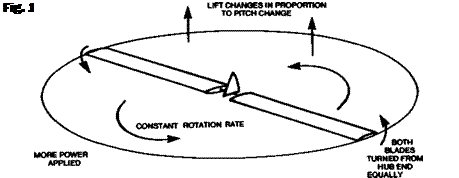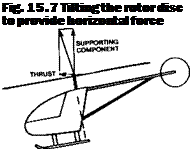TRANSLATIONAL FLIGHT
A helicopter relies on its main rotor for thrust as well as lift. By tilting the plane of rotation (Figure 15.7) the lift vector is inclined forwards (or in another direction) and the resolved forces then move the aircraft horizontally. The direction of the motion is not dependent on the alignment of the fuselage, but only on the tilting of the rotor disc. Thus helicopters can move sideways or backwards with ease. To save fuselage drag in normal operations, the tail rotor is used to align the body with the flight direction.
Once moving, less engine power is needed, at a given altitude, than when hovering. The situation is roughly comparable to the efficiency of a propeller when not moving forward and when flying fast. In a given unit of time, a larger mass of air moves through the actuator disc, so the thrust, or lift, required can be obtained by giving a smaller

Fig. 15.6 The vortex ring
 |
momentum to a large mass instead of a large momentum to the smaller quantity of air. Because of this, helicopters are capable of very much higher flight ceilings when in translational flight than hovering. In marginal take-off conditions it is possible to use the ground effect to get off the ground and immediately to move forward, taking advantage of the increased efficiency to gain height.











